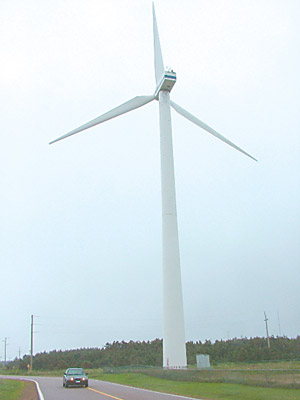 North Cape, PEI, Canada. A150 foot tower and generator with 60 foot blades that that turn a 660KW turbine. The windmills are controlled by computers, and operate in ideal wind conditions, but very difficult weather conditions a few yards from the edge of the Gulf of St. Lawrence. Photo by Fishermen's Voice
North Cape, PEI, Canada. A150 foot tower and generator with 60 foot blades that that turn a 660KW turbine. The windmills are controlled by computers, and operate in ideal wind conditions, but very difficult weather conditions a few yards from the edge of the Gulf of St. Lawrence. Photo by Fishermen's Voice
|
Canada has been developing wind energy projects for the last 25 years. In 1993 an experimental facility was established at North Head, Prince Edward Island.
The 38-acre site on a point of land at the most northern and western part of PEI now has 25 Vesta windmills generating electricity. The first Vestas were installed in 2003 by team of Danish, American, and Canadians.
Conditions at the North Head location are probably the most like those the proposed sites in the Gulf of Maine will experience. Gulf of Maine wind energy sites that the State of Maine is backing will have the added challenge of being offshore.
Wind Energy Insitute Canada’s (WEICan) location at North Cape with 300 degree exposure to the Gulf of St. Lawrence is unique in Canada. The site offers a International Electrotechnical Com- mission (IEC) Class 1 wind resource with relatively low turbulence, a harsh marine environment with high corrosion rates, icing events during winter months, large winter/summer temperature differences.
PEI is home to some of the most progressive wind energy policies in the world. The provincial government is not only investing in more than 40 MW of wind capacity, it has also stated that 100 percent of the province’s electricity will come from wind energy by 2015.
PEI has many locations where utility wind turbines can be exposed to IEC Class 1 winds. There are also various locations where Class 2 and Class 3 winds are available.
PEI has a peak load of only 200 MW, most of which is supplied by an undersea cable connected to New Brunswick.
The North Cape Wind Farm, a 10.56 MW facility, is located adjacent to WEICan. It is owned by the province of Prince Edward Island and is available for a range of utility testing purposes. The location of this facility, at the end of a radial transmission and distribution system, offers a unique opportunity to study such issues as system stability.
The North Cape site has revealed itself to be a demanding environment that has proven it is suitable for Vestas to complete worthwhile measurements.
WEICan was involved in the design, construction and operation of the North Cape Wind Farm. The 10.56 MW wind plant, installed in 2001, consists of sixteen Vestas V-47 wind turbines each with a capacity of 660kW. The installation of the first commercial wind plant in Eastern Canada has been significant in many ways. Not only has it proven to be a good investment for the project owner – the people of PEI – it has been an effective demonstration of the economics of wind power and of the role that wind can play in the regional electricity grid.
The NCWF also provides a valuable platform for investigating the impact of wind turbines on grid stability and on the accuracy of wind forecasting models. Because the NCWF is publicly owned, the operating data is more freely available to research groups with an interest in exploring the impacts of the wind plant.
|





